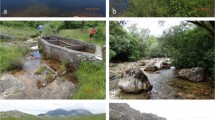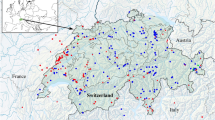Abstract
Arctic and subarctic environments are among the most inaccessible regions in the world, making biological surveys difficult to conduct. Thus, the insect fauna of these regions has remained inadequately surveyed. The aquatic insect orders Ephemeroptera, Plecoptera, and Trichoptera (EPTs) are particularly abundant and diverse at high latitudes, playing key roles in trophic chains where nutrients are scarce. However, particular aspects of their life cycle make them difficult to study. Specifically, species-level identification requires last-instar larvae or adults which, because they are short lived, are typically not available for all taxa during a particular collecting event. With the initial goal of surveying the biodiversity of these insect groups, we sampled ca.10,000 EPT specimens from 12 locations across northern Canada over two years. Approximately 800 of these were subsequently selected for COI DNA barcoding. Overall, we identified 155 EPT species (58 Ephemeroptera, 41 Plecoptera, 56 Trichoptera) based on a 2% divergence criterion. Compared to other similar studies on EPTs we found higher (particularly among the Plecoptera and Ephemeroptera) and more even diversity, potentially reflecting environmental differences in sampling localities. We further assessed phylogeographic divergence patterns among seven species, finding that eastern and western populations diverged during the Pleistocene Epoch (<2.5 Ma), with overlapping time frames. This finding highlights the role of potential glacial refugia and subsequent recolonization, as well as the dispersal potential of some EPT species. This study exemplifies how large-scale DNA-based surveys can be combined with phylogeographic inference to better understand the biodiversity and natural history of northern aquatic insect communities.




Similar content being viewed by others
Change history
11 February 2017
An erratum to this article has been published.
References
Ball SL, Hebert PD, Burian SK, Webb JM (2005) Biological identifications of mayflies (Ephemeroptera) using DNA barcodes. J N Am Benthol Soc 24:508–524
Benke AC, Van Arsdall TC, Jr Gillespie DM (1984) Invertebrate productivity in a subtropical blackwater river: the importance of habitat and life history. Ecol Monogr 54:25–63
Bernatchez L, Wilson CC (1998) Comparative phylogeography of Nearctic and Palearctic freshwater fishes. Mol Ecol 7:431–452
Bickford D, Lohman DJ, Sodhi NS, Ng PKL, Meier R, Winker K, Ingram KK, Das I (2007) Cryptic species as a window on diversity and conservation. Trends Ecol Evol 22:148–155
Boumans L, Brittain JE (2012) Faunistics of stoneflies (Plecoptera) in Finnmark, northern Norway, including DNA barcoding of Nemouridae. Norw J Entomol 59:196–215
Clark PU, Mix AC (2000) Global change: ice sheets by volume. Nature 406:689–690
Craft KJ, Pauls SU, Darrow K, Miller SE, Hebert PD, Helgen LE, Novotny V, Weiblen GD (2010) Population genetics of ecological communities with DNA barcodes: an example from New Guinea Lepidoptera. Proc Natl Acad Sci USA 107:5041–5046
Danks HV (1981) Arctic Arthropods: a review of systematics and ecology with particular reference to the North American fauna. Entomol Soc Can, Ottawa
Darriba D, Taboada GL, Doallo R, Posada D (2012) jModelTest 2: more models, new heuristics and parallel computing. Nat Methods 9:772
de Waard JR, Ivanova NV, Hajibabaei M, Hebert PDN (2008) Assembling DNA barcodes: analytical protocols. In: Martin C (ed) Methods in molecular biology: environmental genetics. Humana Press, Totowa, pp 275–293
Drummond AJ, Rambaut A (2007) BEAST: Bayesian evolutionary analysis by sampling trees. BMC Evol Biol 7:214
Drummond AJ, Suchard MA, Xie D, Rambaut A (2012) Bayesian phylogenetics with BEAUti and the BEAST 1.7. Mol Biol Evol 8:1969–1973
Ekrem T, Stur E, Hebert PD (2010) Females do count: documenting Chironomidae (Diptera) species diversity using DNA barcoding. Org Div Evol 10:397–408
Gullan PJ, Cranston PS (2010) The insects: an outline of entomology. Wiley, New York
Hajibabaei M, Ivanova NV, Ratnasingham S, Dooh RT, Kirk SL, Mackie PM, Hebert PD (2005) Critical factors for assembling a high volume of DNA barcodes. Philos Trans R Soc B 360:1959–1967
Hajibabaei M, Singer GA, Hebert PD, Hickey DA (2007) DNA barcoding: how it complements taxonomy, molecular phylogenetics and population genetics. Trends Genet 23:167–172
Hasegawa M, Kishino H, Yano T (1985) Dating of the human-ape splitting by a molecular clock of mitochondrial DNA. J Mol Evol 22:160–174
Hawlitschek O, Hendrich L, Espeland M, Toussaint EF, Genner MJ, Balke M (2012) Pleistocene climate change promoted rapid diversification of aquatic invertebrates in Southeast Australia. BMC Evol Biol 12:142
Hebert P, Gregory TR (2005) The promise of DNA barcoding for taxonomy. Syst Biol 54:852–859
Hebert PDN, Cywinska A, Ball SL, deWaard JR (2003) Biological identifications through DNA barcodes. Proc R Soc Lond B 270:313–321
Hebert PD, Penton EH, Burns JM, Janzen DH, Hallwachs W (2004) Ten species in one: DNA barcoding reveals cryptic species in the neotropical skipper butterfly Astraptes fulgerator. Proc Natl Acad Sci USA 101:14812–14817
Hewitt G (2000) The genetic legacy of the Quaternary ice ages. Nature 405:907–913
Hewitt GM (2004) Genetic consequences of climatic oscillations in the Quaternary. Philos Trans R Soc B 359:183–195
Higgins DG, Sharp PM (1988) CLUSTAL: a package for performing multiple sequence alignment on a microcomputer. Gene 73:237–244
Hopkins DM (1967) The Cenozoic history of Beringia—a synthesis. In: Hopkins DM (ed) The Bering land bridge. Stanford University Press, Stanford, pp 451–484
Keppel G, Van Niel KP, Wardell-Johnson GW, Yates CJ, Byrne M, Mucina L, Schut AGT, Hopper SD, Franklin SE (2012) Refugia: identifying and understanding safe havens for biodiversity under climate change. Global Ecol Biogeogr 21:393–404
Kjaerstad GA, Webb JM, Ekrem TO (2012) A review of the Ephemeroptera of Finnmark-DNA barcodes identify Holarctic relations. Norw J Entomol 59:182–195
Knowles LL (2001) Did the Pleistocene glaciations promote divergence? Tests of explicit refugial models in montane grasshopprers. Mol Ecol 10:691–701
Merritt RW, Cummins KW, Berg MB (2008) An introduction to the aquatic insects of North America. Kendall/Hunt Publishing Company, Dubuque
Monaghan MT, Wild R, Elliot M, Fujisawa T, Balke M, Inward DJ, Lees DC, Ranaivosolo R, Eggleton P, Barraclough TG, Vogler AP (2009) Accelerated species inventory on Madagascar using coalescent-based models of species delineation. Syst Biol 58:298–311
Papadopoulou A, Anastasiou I, Vogler AP (2010) Revisiting the insect mitochondrial molecular clock: the mid-Aegean trench calibration. Mol Biol Evol 27:1659–1672
Paradis E, Claude J, Strimmer K (2004) APE: analyses of phylogenetics and evolution in R language. Bioinformatics 20:289–290
Pielou EC (1991) After the ice age: the return of life to glaciated North America. University of Chicago Press, Chicago
Pons J, Barraclough TG, Gomez-Zurita J, Cardoso A, Duran DP, Hazell S, Kamoun S, Sumlin WD, Vogler AP (2006) Sequence-based species delimitation for the DNA taxonomy of undescribed insects. Syst Biol 55:595–609
R Core Team (2015) R: a language and environment for statistical computing. R Foundation for Statistical Computing, Austria
Rasmussen AK, Morse JC (2014) Distributional checklist of Nearctic Trichoptera (Summer 2014 Revision). Unpublished, Florida A&M University, Tallahassee 487 pp. http://www.Trichoptera.org. Accessed July 28
Ruiter DE (1995) The Adult Limnephilus Leach (Trichoptera: Limnephilidae) of the New World. In: Cafazzo VM (ed) Bulletin new series, Ohio Biol Surv Bull 11:1
Ruiter DE, Boyle EE, Zhou X (2013) DNA barcoding facilitates associations and diagnoses for Trichoptera larvae of the Churchill (Manitoba, Canada) area. BMC Ecol 13:1
Sánchez-Ramírez S, Tulloss RE, Guzmán-Dávalos L, Cifuentes-Blanco J, Valenzuela R, Estrada-Torres A, Ruán-Soto F, Díaz-Moreno R, Hernández-Rico N, Torres-Gómez M, León H, Moncalvo JM (2015) In and out of refugia: historical patterns of diversity and demography in the North American Caesar’s mushroom species complex. Mol Ecol 24:5938–5956
Smith MA, Rodriguez JJ, Whitfield JB, Deans AR, Janzen DH, Hallwachs W, Hebert PD (2008) Extreme diversity of tropical parasitoid wasps exposed by iterative integration of natural history, DNA barcoding, morphology, and collections. Proc Natl Acad Sci USA 105:12359–12364
Ståhls G, Savolainen E (2008) MtDNA COI barcodes reveal cryptic diversity in the Baetis vernus group (Ephmeroptera, Baetidae). Mol Phylogenet Evol 46:82–87
Tavaré S (1986) Some probabilistic and statistical problems in the analysis of DNA sequences. In: Miura RM (ed.) Some mathematical questions in biology–DNA sequence analysis. Lectures on mathematics in the life sciences, American Mathematical Society, 17:57–86
Velonà A, Brock PD, Hasenpusch J, Mantovani B (2015) Cryptic diversity in Australian stick insects (Insecta; Phasmida) uncovered by the DNA barcoding approach. Zootaxa 3957:455–466
Webb JM, Jacobus LM, Funk DH, Zhou X, Kondratieff B, Geraci CJ, DeWalt RE, Baird DJ, Richard B, Phillips I, Hebert PD (2012) A DNA barcode library for North American ephemeroptera: progress and prospects. Plos One 7:e38063
Wiggins GB (1996) Larvae of the North American caddisfly genera (Trichoptera). University of Toronto Press, Toronto
Wiggins GB, Richardson JS (1986) Revision of the Onocosmoecus unicolor group (Trichoptera: Limnephilidae, Dicosmoecinae). Psyche 93:187–216
Witt JDS, Threloff DL, Hebert PDN (2006) DNA barcoding reveals extraordinary cryptic diversity in an amphipod genus: implications for desert spring conservation. Mol Ecol 15:3073–3082
Zhou X, Adamowicz SJ, Jacobus LM, Dewalt RE, Hebert PDN (2009) Towards a comprehensive barcode library for arctic life—Ephemeroptera, Plecoptera, and Trichoptera of Churchill, Manitoba, Canada. Front Zool 6:30
Zhou X, Jacobus LM, Dewalt RE, Adamowicz SJ, Hebert PDN (2010) Ephemeroptera, Plecoptera, and Trichoptera fauna of Churchill (Manitoba, Canada): insights into biodiversity patterns from DNA barcoding. J N Am Benthol Soc 29:814–837
Acknowledgements
The authors acknowledge the contributions of other members of the Northern Biodiversity Program (C. Buddle, T. Wheeler, D. Giberson, S. Loboda, K. Sim, L. Timms, M. Blair, A. Solecki, P. Schaeffer) for specimen collection and sorting. Thanks are owed to the following taxonomic specialists for confirmation of species-level identifications based on morphology: Ephemeroptera (S. Burian, Southern Connecticut State University), Plecoptera (R. Baumann, Brigham Young University and B. Kondratieff, Colorado State University), and Trichoptera (D. Ruiter, Grants Pass, Oregon). This work was supported by a National Science and Engineering Research Council of Canada (NCERC) Strategic Project Grant (Ecological Structure of Northern Arthropods: Adaptation to a Changing Environment) awarded to C. Buddle and T. Wheeler (McGill University) and DCC, plus their supporting partners and collaborators. Additional support was provided by NSERC Discovery- and Schad Conservation Grants to DCC. SSR thanks the National Council for Science and Technology of Mexico (CONACyT) for a PhD scholarship.
Author information
Authors and Affiliations
Corresponding author
Ethics declarations
Conflict of interest
The authors declare that they have no conflict of interest.
Additional information
Ruben D. Cordero and Santiago Sánchez-Ramírez have contributed equally to this work.
An erratum to this article is available at https://doi.org/10.1007/s00300-017-2078-3.
Electronic supplementary material
Below is the link to the electronic supplementary material.
ESM 1
List of the species and GenBank accession numbers from Zhou et al. (2009, 2010) of the COI barcode sequences included in this study. (PDF 91 kb)
ESM 2
Specimen information. List with detailed information for each sequenced (COI barcoded) specimen. (PDF 803 kb)
ESM 3
Ephemeropteran maximum clade credibility tree. Shadowed taxa exhibit both genetic and geographic structure. Black bars indicate species that show genetic divergence but no geographic structure. The three letter code after the species name describes the Order (E for Ephemeroptera) and the site where sampled: BI-Banks Island, CB-Cambridge Bay, CH-Churchill, GB-Goose Bay, IQ-Iqaluit, KT-Kugluktuk, MO-Moosonee, NW-Norman Wells, OM-Ogilvie Mountains, SV-Schefferville, YK-Yellowknife. The three numbers after the letters represent the specimen. (PDF 619 kb)
ESM 4
Plecopteran maximum clade credibility tree. Shadowed taxa exhibit both genetic and geographic structure. Black bars indicate species that show genetic divergence but no geographic structure. The three letter code after the species name describes the Order (P for Plecoptera) and the site where sampled: BI-Banks Island, CB-Cambridge Bay, CH-Churchill, GB-Goose Bay, IQ-Iqaluit, KT-Kugluktuk, MO-Moosonee, NW-Norman Wells, OM-Ogilvie Mountains, SV-Schefferville, YK-Yellowknife. The three numbers after the letters represent the specimen. (PDF 437 kb)
ESM 5
Trichopteran maximum clade credibility tree. Shadowed taxa exhibit both genetic and geographic structure. Black bars indicate species that show genetic divergence but no geographic structure. The three letter code after the species name describes the Order (T for Trichoptera) and the site where sampled: BI-Banks Island, CB-Cambridge Bay, CH-Churchill, GB-Goose Bay, IQ-Iqaluit, KT-Kugluktuk, MO-Moosonee, NW-Norman Wells, OM-Ogilvie Mountains, SV-Schefferville, YK-Yellowknife. The three numbers after the letters represent the specimen. (PDF 724 kb)
Rights and permissions
About this article
Cite this article
Cordero, R.D., Sánchez-Ramírez, S. & Currie, D.C. DNA barcoding of aquatic insects reveals unforeseen diversity and recurrent population divergence patterns through broad-scale sampling in northern Canada. Polar Biol 40, 1687–1695 (2017). https://doi.org/10.1007/s00300-016-2062-3
Received:
Revised:
Accepted:
Published:
Issue Date:
DOI: https://doi.org/10.1007/s00300-016-2062-3




